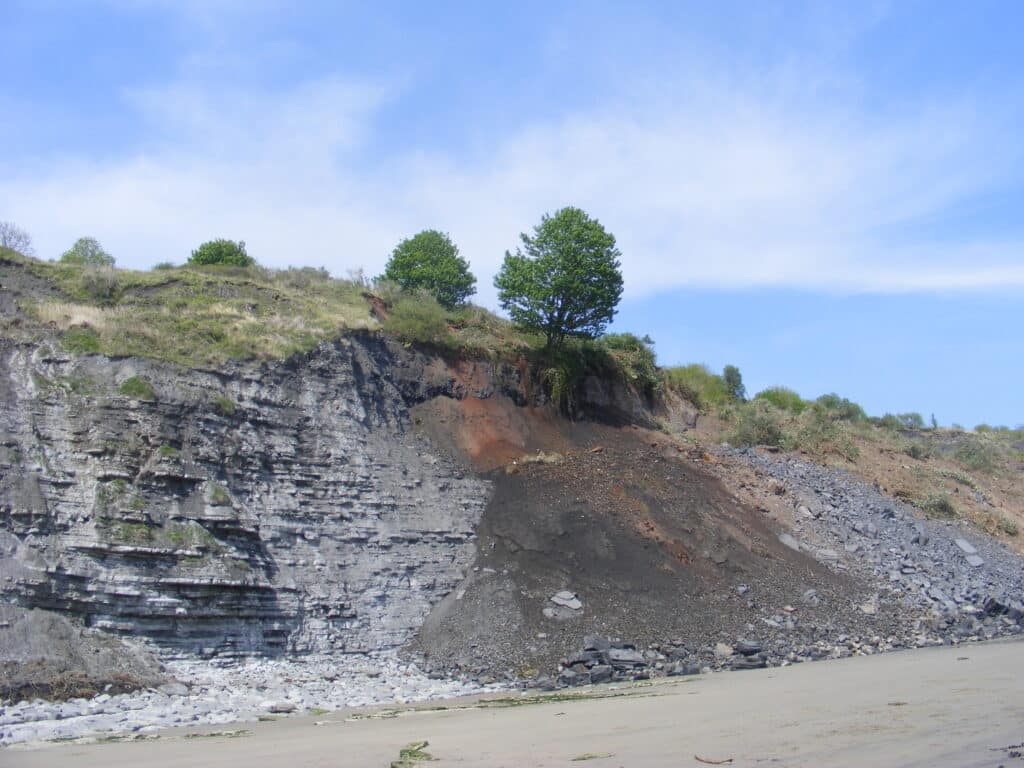The coastal section from Charmouth to Lyme Regis can be studied from beach level as long as you select your walk to coincide with spring tides when there is a low tide around lunchtime. Unfortunately due to land slips and problems of access through the property of the Lyme Regis Golf Club, the coast path has has been diverted well in land.The rocks exposed between Charmouth and Church Cliffs Lyme Regis are again Lower Lias Clays (Charmouth Formation – Blue Lias, Shales with Beef and Black Ven Marl in ascending order) capped with Cretaceous Upper Greensand.

As explained earlier this is an ideal situation for mass movement (land slips) and Black Ven provides classic examples of clay flows and rotational slip as seen in the picture above. It should be remembered that it is potentially very dangerous to walk on the landslip area even in apparently dry conditions. Before leaving Charmouth it is worth visiting the Charmouth Heritage Centre to find our more about the geology and natural history of the area. They also run fossil collecting trips.
The Jurassic rocks in this area were deposited in a relatively shallow sub-tropical sea but in quiet water conditions hence the predominantly muddy sequence of rocks although limestone bands do occur especially in the Blue Lias. The beds are fossiliferous with many ammonites although these are often crushed as in the picture below. In this case the original shell has been preserved but the ammonites are often pyritised and gold in colour (fool’s gold).

Other fossils include bivalves, brachiopods, belemnites and crinoids. The picture below shows a bed which is rich in belemnites. These are a variety of cephalopod related to modern day squid.

Occasionally more exotic fossils can be found such as marine reptiles (ichthyosaurs and plesiosaurs) and the area was initially made famous by the collecting skills of Mary Anning in the first half of the 19th century.
Some beds are very ammonite rich for example the Shales with Beef Member, however the fossils are not always very well preserved. Beef is fibrous calcite and can look rather likemeat with a little imagination! This forms in rocks which are relatively rich in organic material (hydrocarbon rich orginally derived from plankton ) and these Lower Jurassic rocks are the likely source of much of the oil and gas that has been found and exploited at Kimmeridge and Wytch Farm (east Dorset). (See instalment 5 of Rock along the Coast which covers the Kimmeridge area.)
The view below is of the eastern part of Black Ven looking towards Charmouth (white building in the distance) and shows the grey clays of the Black Ven Marl with occasional beds of limestone. Also note the gentle dip of the rocks to the east typical of much of the Jurassic Coast.

As you get closer to Lyme Regis you will notice more limestone in the rock sequence with the Blue Lias. It is thought that the rhythmic succession of clay and limestone was due to long term (over ten of thousands of years) climatic fluctuations called Milankovic Cycles.

Church Cliff experienced a major landslip in May 2008 but fortunately no one was hurt as it occurred at high tide and in the evening so the beach was deserted. However clay slipped over the cliff carrying debris from Lyme’s former town refusetip! The tree on the cliff top fell while I was there.

The section from Church Cliffs into Lyme Regis has been transformed in the last 2 years or so despite the extreme storm events of the winter of 2013-14. The old coastal defences from the 1950s had fallen into disrepair and were ineffective and now there is a new sea wall, esplanade walk, which allows easier access to the beach east of Lyme, as well as steps down from the Charmouth Road carpark. These allow much easier and safer access to the centre of Lyme.The picture below shows the situation in 2008 with clay slumping over the old sea wall, groynes in disrepair and temporary drainage trying to remove water to help limit mass movement. The second picture shows the new sea wall and the ruinedgroynes having been removed.


Alan Holiday
PLEASE SUPPORT US FOR JUST £2 A MONTH







